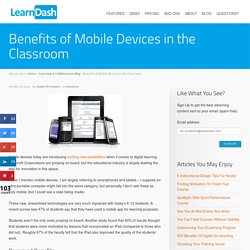

Cellphones in the Classroom: Distraction or Tool? The final version of the National Education Technology Plan (NETP) was released last week, setting forth the Obama Administration's plan for improving access to and integration of technologies for teaching and learning.

Among the recommendations the Department of Education makes in the NETP is a call for support for "efforts to ensure that all students and educators have 24/7 access to the Internet via devices, including mobile devices, and that states, districts, and schools adopt technologies and policies to enable leveraging the technology that students already have. " The push for "24/7 access to the Internet" falls under another the auspices of yet another endeavor, the National Broadband Plan.
But the call for better access to Internet-ready devices, particularly utilizing tools the students already possess is an interesting one. Because the device that is ubiquitous for American students isn't the desktop computer or the notebook or the netbook or the iPad. It's the cellphone. Mobile Devices in the Classroom. As cell phones—with ever-expanding possibilities of texting, Web browsing, and game playing—have multiplied in recent years among teenagers and even preteens, so have the concerns of teachers and administrators about the distractions these devices can cause.

A survey of students and parents earlier this year by the group Common Sense Media found that almost 70 percent of schools around the country ban student cell phone use during the school day. But some districts and administrators are realizing the untapped potential of cell phones. It’s part of an “anytime, anywhere” learning movement that leaves laptops and even smaller netbooks behind, proponents say, in favor of more mobile, affordable and reliable handheld devices—from “smartphones,” which can run operating systems such as Windows Mobile and a host of software, to iPods, known more for playing audio and video but adaptable to more interactive applications through new educational platforms (see the sidebar on mobile devices).
Education Update:Make Parents Your Partners:Can Mobile Devices Transform Education? The popularity of smartphones, including Droids, iPhones, and BlackBerries, that now have GPS, texting, voice, and multimedia capabilities has prompted industry and education reformers to shine the light on these mobile devices as vehicles suitable for transforming K–12 learning for the 21st century.

Although they present challenges as well as potential benefits, education experts reason that these powerful small computers motivate students; provide constant access to the wealth of knowledge, tools, and experts on the web; and are cheaper and more plentiful than laptops or desktop workstations. "A big choice for us is: we have this very flexible tool, much more like a Swiss army knife than a hammer. What do we want to use it for? " says Christopher Dede, Timothy E. Wirth Professor in Learning Technologies at Harvard University's Graduate School of Education. From Distraction to Learning Tool: Mobile Devices in the Classroom. Mobile | Feature From Distraction to Learning Tool: Mobile Devices in the Classroom A journalism professor at the University of Maryland is using tablets to engage his students.

Once banned in the classroom, mobile devices are becoming more accepted as a teaching and learning tool. Yet teaching methods have not caught up with mobile's potential, according to Ron Yaros, assistant professor of new media and mobile journalism at the University of Maryland's Philip Merrill College of Journalism. "Under the current methods of teaching in higher education, a mobile device can be a distraction rather than a helpful tool," said Yaros. His assertion is backed up by a recent University of Central Florida survey on mobile learning practices in higher education: Among students who owned a tablet, 82 percent said they used the device for academic purposes. Benefits of Mobile Devices in the Classroom. Mobile devices today are introducing exciting new possibilities when it comes to digital learning.

For-profit Corporations are jumping on board, but the educational industry is largely leading the way for innovation in this space. When I mention mobile devices, I am largely referring to smartphones and tablets – I suppose an ultra-portable computer might fall into the same category, but personally I don’t see these as truly mobile (but I could see a case being made). These new, streamlined technologies are very much ingrained with today’s K-12 students. A recent survey saw 47% of students say that they have used a mobile app for learning purposes. Students aren’t the only ones jumping on board. Perceived Benefits So what makes mobile devices so appealing in a classroom setting?
In addition to finding real-time information, an app can also provide a student with a convenient study tool. Which leads into another major benefit of mobile learning: it is extremely portable. Some Downsides.